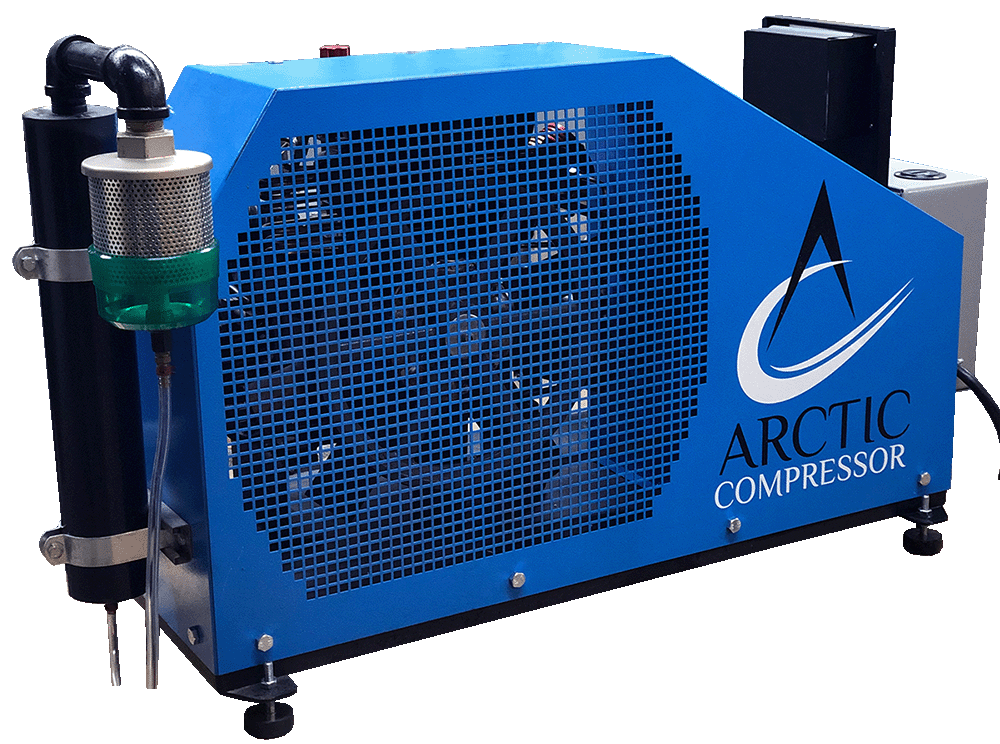When it comes to high-pressure breathing air compressors, the choice between a 3-stage and a 4-stage model can significantly impact performance and efficiency. Whether you’re a firefighter, working in demanding industrial environments, or conducting rigorous testing, understanding the difference between these compressor stage types is crucial. Join us as we dive into the great compression showdown.
Compressor stages play a crucial role in the overall performance of the model, increasing the efficiency and performance of the entire breathing air system. The fundamental design of multi-stage compression is to divide the compression process into multiple stages for increased power. The compression is achieved by employing a series of decreasing diameter cylinder stages, and intercoolers that cool the air between each of these stages.
As air is compressed, its temperature rises, and the moisture level increases. So, to produce high-quality air, the temperature needs to be lowered and the moisture removed. This is where intercoolers and moisture separators come into play.
Intercoolers and moisture separators are placed between compression stages to remove moisture and reduce the overall temperature. Removing the heat ensures that critical temperatures are not exceeded, which would put strain on the model – shortening its lifespan or causing mechanical failure.
Breaking down how a multi-stage compressor works simply – ambient air is brought in through the air intake and goes through multiple stages of compression (3 or 4), with intercoolers between each stage. The air is also cooled after the final stage before being used.
Three Stages
The final stage compressed air is cooled and moisture is removed.
The final stage compressed air is cooled and moisture is removed.
A multi-stage compressor offers several benefits and advantages over single-stage compressors.
By going through multiple stages, the compressed air is much more energy efficient, especially at higher pressures.
Intercooling between stages allows for better heat management, reducing the heat before use. This is especially important for breathing air applications.
Multi-stage compressors are designed to achieve higher pressure levels more efficiently than single-stage compressors. While single-stage compressors can theoretically reach high pressures, they would require an impractically large motor and be highly inefficient. More stages allow for better heat dissipation between compression cycles, resulting in more efficient operation, especially at higher pressures.
Some multi-stage compressors reach a staggering 6000 PSI, including Arctic Compressor’s enclosed and open-frame compressors.
By using intercoolers and moisture separators, multi-stage compressors remove moisture from the air, allowing the purification systems to produce high-quality, breathing-grade air.
3-stage air compressors are commonly used for fire departments, industrial pressure testing, SCUBA diving, paintball, and PCP air rifles. Well suited for most small and medium air volume applications, 3-stage compressors are a popular choice.
Arctic Compressor three-stage Enclosed and Open Frame compressors are designed to operate up to 6000 PSI, making them an ideal choice for numerous applications.
Longer continuous run times and larger volumes of high-pressure air would be much better suited for a 4-stage compressor. These units are often used for medium or large fire stations, industrial applications, or medium to large dive teams.
4-stage compressors are more energy efficient than 3-stage compressors With the same energy input, a 4-stage compressor will produce more compressed air than a 3-stage compressor.
However, 4-stage compressors are more mechanically complex than 3-stage compressors. They have an additional stage, which involves more components and parts.
Most Powerful
18 - 24 CFM
6000 PSI
83dB
57,000 - 90,000 Cu. Ft.
15 - 20 HP
9 - 14 CFM
6000 PSI
76 dB
24,000 - 57,000 Cu. Ft.
7.5 - 10 HP

9 - 14 CFM
6000 PSI
92 dB
9,800 - 24,000 Cu. Ft.
7.5 - 10 HP
The trade-off between 3 and 4-stage compressors is one of mechanical complexity vs energy efficiency.
A 3-stage compressor is less mechanically complex than a 4-stage compressor. However, given the same energy input, the 3-stage compressor will output less compressed air than the equivalent-sized 4-stage compressor. With the additional efficiencies, 4-stage systems also operate comparatively cooler.
When choosing high-pressure air equipment, it’s important to consider the reliability and quality of what you’re purchasing.
Known for reliability and Truly American-Made™ equipment, Arctic Compressor offers 3 and 4-stage high-pressure compressors to fit your needs. Ranging from the powerful 2500 Enclosed Series Compressor (4-stage) to our 1000 Open Frame Series Compressor (3-stage), we offer a compressor at a price point that works for you, without compromising quality.
Most high-pressure air compressors take several months from order submission to installation. However, at Arctic Compressor, we boast over 9 times faster delivery and lead times than our competitors. We are able to offer these fast turnaround times from our Truly American-Made™ values – we have complete control of our manufacturing – all of which is conducted in the United States at our headquarters in Superior, WI.
Phone:
Copyright 2025 – Arctic Compressor “The simple Choice”. All rights Reserved